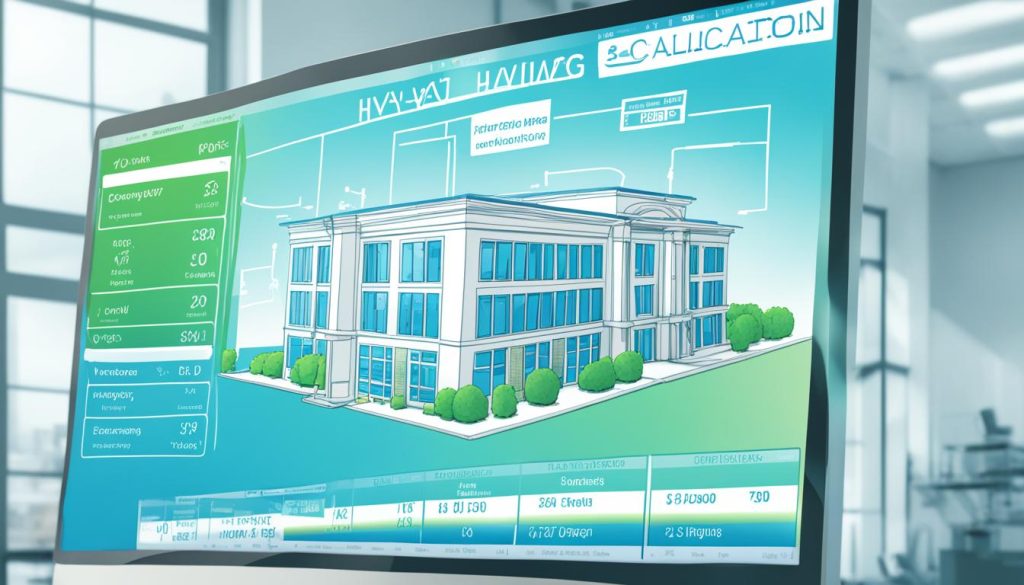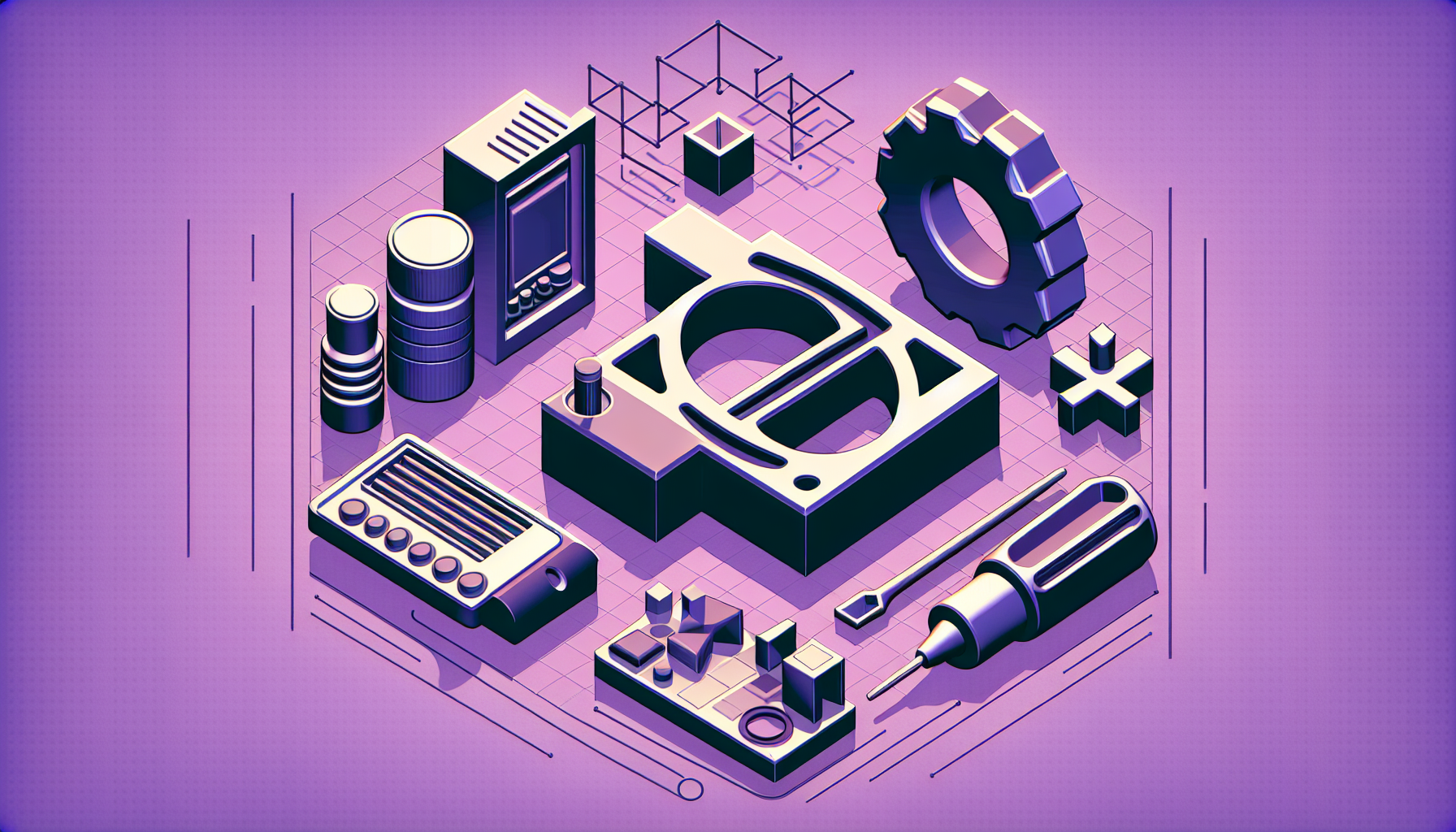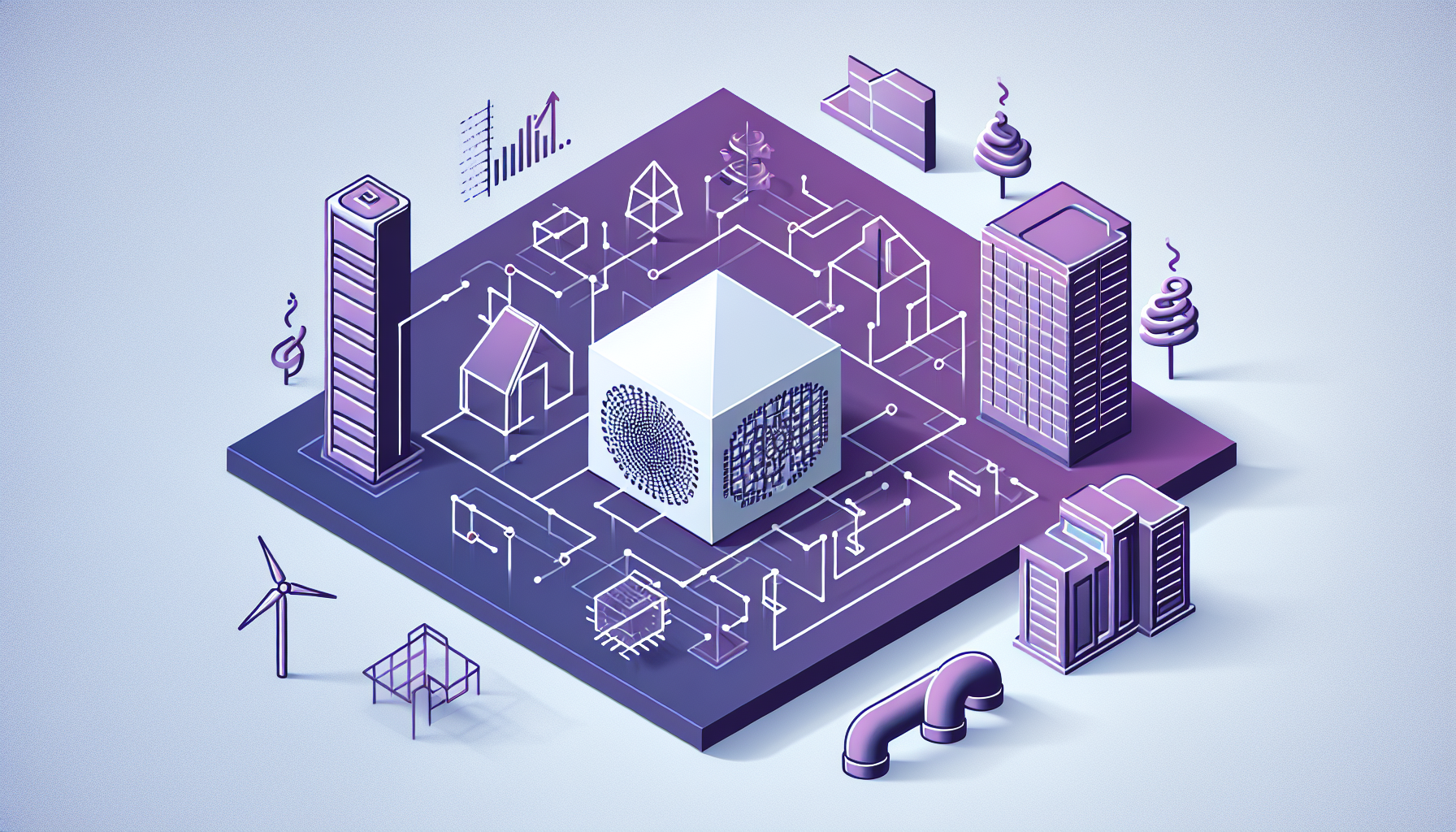Using HVAC load calculation software helps make your heating and cooling systems more efficient. This tool looks at your building’s size, climate, insulation, and how many people use it. It then figures out the best size HVAC system for your space.
Today’s HVAC load calculation software works with Building Information Modeling (BIM) and analyzes data in real-time. This helps you make better decisions. With these tools, you can create HVAC systems that use less energy and work better. This saves money and keeps everyone comfortable.
We’ll look at how to use HVAC load calculation software to make your heating and cooling systems more efficient and green. Let’s dive into how you can make your projects more sustainable.
Understanding HVAC Load Calculation Software
HVAC load calculation is key to designing efficient heating and cooling systems for buildings. With a focus on sustainable design, knowing how to use HVAC load estimation tools is vital for professionals.
What is HVAC Load Calculation?
HVAC load calculation finds out how much heating or cooling a building needs to stay comfortable. It looks at building size, insulation, how many people use it, and the local weather. Getting it right helps pick the right equipment, saves energy, and makes sure everyone is comfortable.
Evolution of Load Calculation Methods
The way we calculate HVAC loads has changed a lot:
- Manual calculations using pen and paper
- Spreadsheet-based computations
- Specialized software programs
- Advanced tools integrating Building Information Modeling (BIM)
Now, we have advanced HVAC load estimation tools that are very accurate and efficient.
Benefits of Using Software for Load Calculations
Using software for HVAC load calculations has many benefits:
| Benefit | Impact |
|---|---|
| Improved Accuracy | Reduces errors in system sizing |
| Time Savings | Speeds up calculation process |
| Cost Efficiency | Optimizes equipment selection |
| Energy Savings | Supports energy-saving HVAC strategies |
| Compliance | Ensures adherence to building codes |
These tools are crucial for sustainable building design. They help make HVAC systems that save energy.
The Importance of Accurate Load Calculations
Getting load calculations right is key to a well-working HVAC system. It helps size your system perfectly for your building. This means your space stays comfortable and uses less energy.
Choosing the right size for your HVAC system is vital for saving energy. If your system is too big, it uses too much energy by turning on and off too much. If it’s too small, it can’t keep up with the cooling or heating needs. Correct calculations help avoid these problems, making your system more efficient and cutting costs.
Here are the main benefits of accurate load calculations:
- Improved comfort for occupants
- Reduced energy consumption
- Lower maintenance costs
- Extended equipment lifespan
- Compliance with building codes
For the best HVAC performance, start with detailed load calculations. These take into account your building’s size, insulation, window setup, and how many people use it. This way, your HVAC system works efficiently.
Wrong calculations can cause big problems. A system that’s too big will cycle on and off too much, making temperatures unstable and wearing out parts faster. A system that’s too small will work too hard, making the air quality bad and increasing your bills. Both cases make people unhappy and don’t help the environment.
Putting effort into precise load calculations is smart. It sets up your HVAC for success, making it efficient and reliable for years.
Key Features of HVAC Load Calculation Software
HVAC load calculation software has changed how experts work on sustainable buildings and save energy. These tools make it easier to do HVAC energy audits and improve system performance.
Building Information Modeling (BIM) Integration
Modern HVAC software works well with BIM platforms. This means designers can easily add building data to the software. It leads to a clearer picture of the building’s heat needs, helping make better design choices.
Real-time Data Analysis Capabilities
Real-time data analysis is a big deal for HVAC pros. It lets you quickly adjust your plans as conditions change. This keeps your load calculations up-to-date, helping you save energy.
Compatibility with Artificial Intelligence
AI makes HVAC load calculation even better. It uses learning algorithms to predict energy use and suggest ways to save. This helps make better decisions and improve building performance.
| Feature | Benefit | Impact on Energy Efficiency |
|---|---|---|
| BIM Integration | Streamlined workflow | More accurate thermal modeling |
| Real-time Analysis | Quick adjustments | Optimized system performance |
| AI Compatibility | Predictive modeling | Enhanced energy-saving strategies |
These features of HVAC load calculation software help you design more efficient buildings. By using these tools, you can do detailed energy audits and save energy. This makes buildings work better overall.
Selecting the Right HVAC Load Calculation Software
Choosing the right HVAC load estimation tools is key for designing efficient HVAC systems. You must think about several things when picking software for sizing HVAC systems.
Start by looking at your project’s needs. Home projects might need different tools than business ones. It’s important that the software is easy to use, especially if you’re new to this.
Make sure the software can work well with other tools you use, like Building Information Modeling (BIM) platforms. This makes your work flow better and helps you be more accurate.
Think about the types of calculations the software does. For homes, manual J calculations are common. For businesses, ASHRAE methods are often used. Make sure the software can do the right calculations for your projects.
| Software Feature | Importance |
|---|---|
| Project-specific calculations | High |
| User-friendly interface | Medium |
| Integration capabilities | High |
| Calculation methods | High |
| Customization options | Medium |
Customization options let you make the software fit your needs. Look for tools that let you change settings and create your own reports. This makes your work better and more precise.
By thinking about these things, you can pick HVAC load calculation software that meets your needs. This helps you design more efficient HVAC systems.
Improve Energy Efficiency with Load Calculation Software
Load calculation software is key to making HVAC systems more energy efficient. It helps you make your building work better and use less energy.
Optimizing System Design for Energy Savings
HVAC load calculation software lets you adjust your system for the best energy savings. It ensures your equipment is the right size, avoiding waste from systems that are too big or too small. This means your HVAC runs efficiently, supporting green building practices.
Reducing HVAC Energy Consumption
Using load calculation software cuts down on HVAC energy use. It gives you exact heating and cooling load figures. This helps you keep the space comfortable while using less energy. It’s a smart way to save energy.
Enhancing Overall Building Performance
Load calculation software does more than just help with HVAC. It makes the inside of your building more comfortable, lowers costs, and reduces harm to the environment. These benefits help you build a greener, more efficient structure.
| Benefit | Impact |
|---|---|
| Precise system sizing | Eliminates energy waste |
| Accurate load calculations | Optimizes energy consumption |
| Improved comfort levels | Enhances occupant satisfaction |
| Reduced operational costs | Increases building value |
Adding load calculation software to your HVAC design boosts energy efficiency, cuts costs, and makes buildings more comfortable and sustainable.
Implementing Load Calculation Software in Your HVAC Projects
Using HVAC load calculation software changes how you design systems and manage energy. It makes your work flow better and helps you size HVAC systems more accurately.
First, pick a software that fits your project’s needs. Teach your team how to use it right, focusing on entering data correctly. This is key for getting trustworthy results and making HVAC systems use less energy.

Take advantage of features like automatic equipment picking and duct size advice. These tools make designing HVAC systems faster and more efficient.
Set up checks to keep your work consistent. Regularly update the software and train your team to keep your HVAC load calculations top-notch.
| Implementation Step | Benefits |
|---|---|
| Software Selection | Tailored solutions for project needs |
| Team Training | Improved accuracy in data input |
| Feature Utilization | Enhanced efficiency in system design |
| Quality Control | Consistent results across projects |
By following these steps, you’ll use HVAC load calculation software to its fullest. This leads to better system sizing and more energy efficiency in your projects.
Case Studies: Successful Energy Efficiency Improvements
Real-world examples show how HVAC load calculation software boosts energy efficiency. Let’s look at three case studies. They highlight the importance of precise calculations in different settings.
Commercial Office Building Retrofit
A 20-story office tower in Chicago got a big HVAC upgrade. Engineers used advanced load calculation software to find ways to improve. They put in energy-efficient HVAC systems that fit the building’s needs.
The result was a 30% drop in energy use and $200,000 less spent on utilities each year.
Healthcare Facility Optimization
A hospital in Texas struggled with keeping the right temperature and humidity. HVAC energy audits showed where the system was losing efficiency. By using load calculation software, the hospital made its HVAC better.
This led to better patient comfort, a 25% cut in energy use, and made sure it met strict health rules.
Residential Construction Efficiency
A new housing project in California focused on sustainability from the beginning. It used HVAC load calculation software to get the systems just right. This meant no homes had systems that were too big or too small.
Now, homeowners are more comfortable and save about 20% on their energy bills. This is compared to similar homes without these precise calculations.
| Case Study | Energy Savings | Key Benefit |
|---|---|---|
| Commercial Office | 30% | $200,000 annual cost savings |
| Healthcare Facility | 25% | Improved patient comfort |
| Residential Development | 20% | Right-sized systems for each home |
These case studies show that accurate HVAC load calculations lead to big wins. They bring energy savings, better comfort, and lower costs over time for different types of buildings.
Overcoming Challenges in HVAC Load Calculation Software Adoption
Adopting HVAC load calculation software can change the game for energy-efficient HVAC systems. But, many companies face hurdles when they try to use these tools. Let’s look at some common challenges and how to get past them.

One big hurdle is the fear of change. Some HVAC pros prefer old methods and are slow to accept new tech. To overcome this, companies should show how HVAC load calculation software improves accuracy and can save energy.
Learning new software can be tough. Offering thorough training can help staff get good at it. Workshops and ongoing support can make the switch smoother and increase confidence in using the software.
Getting the software to work with your current systems can be hard. It’s important to pick software that fits with your design tools and building management systems. This makes data sharing smooth and avoids workflow problems.
| Challenge | Solution |
|---|---|
| Resistance to change | Demonstrate benefits and ROI |
| Learning curve | Provide comprehensive training |
| Integration issues | Choose compatible software |
| Data accuracy concerns | Implement quality control measures |
Getting accurate data is key with HVAC load calculation software. Use quality checks and regular audits to keep data consistent. This builds trust in the software and helps design more efficient HVAC systems.
By tackling these challenges, you can successfully use HVAC load calculation software. This leads to better energy efficiency and better system sizing.
Future Trends in HVAC Load Calculation Technology
The future of HVAC load calculation technology is exciting. It will change how we use energy-efficient HVAC systems and design buildings sustainably. We’re seeing big changes coming our way.
Machine Learning and Predictive Modeling
Machine learning is changing HVAC load estimation tools. These systems use past data, weather forecasts, and how buildings are used to predict future loads. This means they can adjust energy use and comfort levels on the fly.
Integration with Smart Building Systems
Linking HVAC load calculation software with smart building systems is a big deal. It lets different parts of the building talk to each other. This creates a better way to manage energy use.
Sensors in the building send data to the HVAC system. This lets it make quick changes based on how many people are there, the temperature, and other things.
Cloud-based Solutions and Remote Accessibility
Cloud-based HVAC load calculation tools are becoming popular. They let engineers and managers check and improve systems from anywhere. This move to the cloud makes working together easier and helps make better decisions for saving energy.
As these technologies get better, we’ll see even more advanced HVAC load estimation tools. They will help make buildings smarter and more efficient. The future of HVAC technology looks bright, with big gains in energy savings and helping the environment.
Conclusion
HVAC load calculation software is changing the game for energy-efficient HVAC systems. It uses advanced features and works with the latest technologies. This helps HVAC experts design systems that use less energy and are better for the planet.
As technology gets better, using HVAC load calculation software will lead to better energy use and care for the environment. These tools help make HVAC designs more accurate and support sustainable building practices. They use real-time data and artificial intelligence for better predictions and improvements.
The future looks bright for HVAC load calculation software. With new tech like machine learning and cloud-based solutions, these tools will get even more powerful. By using these advancements, you’ll be ready to meet the need for energy-efficient buildings. This will help make the HVAC industry more sustainable.





0 Comments